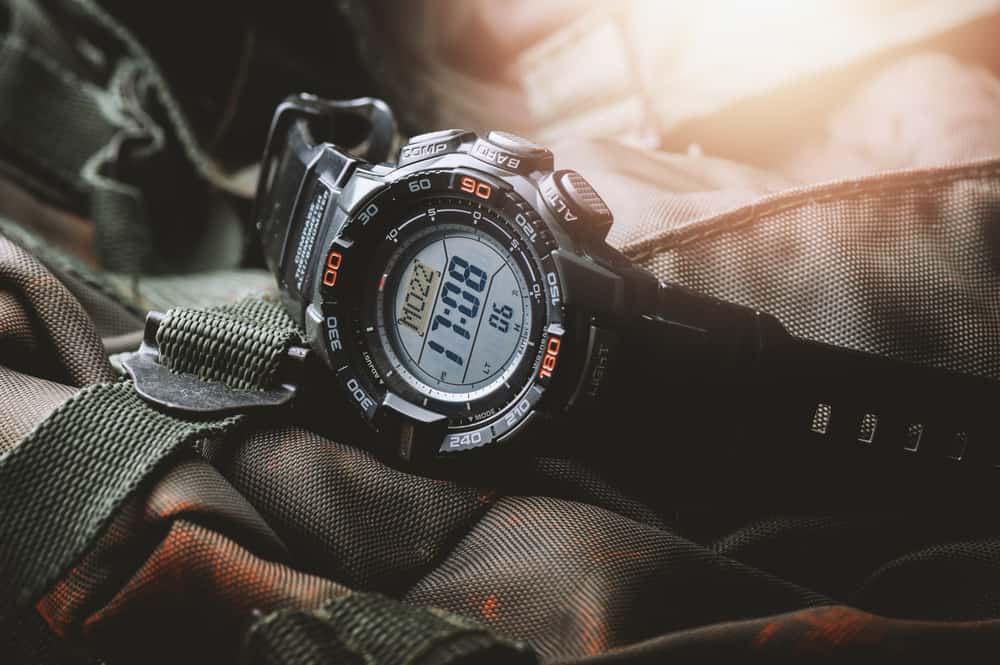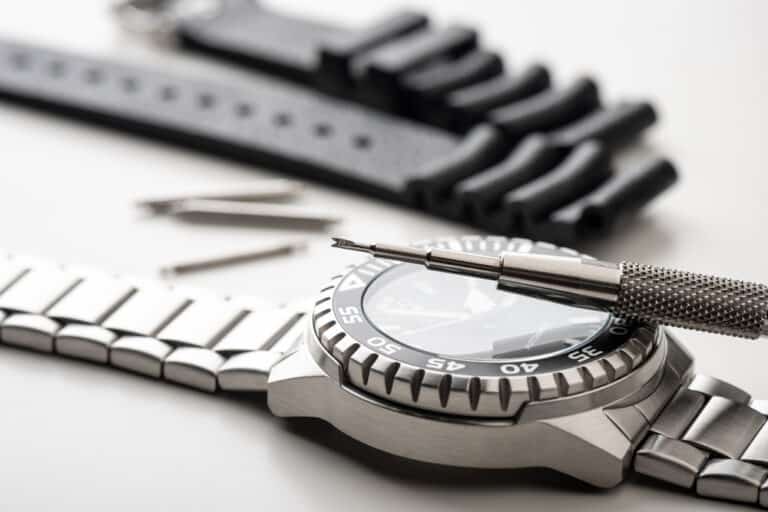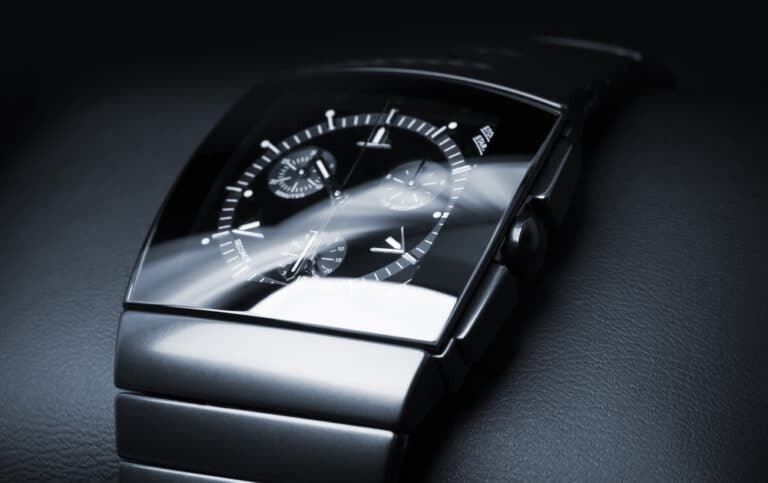Although not many people think about what plastic is used to make watches, you’ll be surprised how many types are used in watch manufacturing. Some of these plastics are pricier than others, but they are all incorporated into timepieces to add value, whether it be reinforcement, water resistance, or aesthetic appeal.
Seven of the most frequently used plastics for watches include
- Polymers & Thermoset
- 100% Recycled Plastic
- Poly Methyl Methacrylate (PMMA)
- ABS (acrylonitrile butadiene styrene)
- Nylon Polyamide
- Reinforced Polymer Composites
- Acrylic Watch Glass
If you are curious about which plastics are used to make watches, this article will discuss the various plastics that watch manufacturers use in this day and age to produce several impressive timepieces.
1. The Use Of Polymers & Thermoset Polymers In Watchmaking
The polymer starts as a fluid or a pliable solid. Thermosetting (or thermoset) polymer is another name for this substance.
Increases in pressure or a catalyst can speed up the curing process, which is necessary since heat is used to power chemical reactions that strengthen the cross-linking between the polymer chains, ultimately curing the plastic.
When subjected to the stresses of being shaped, polymers often acquire a three-dimensional, cross-linked structure and strong covalent bonds, which help them maintain their structure and stiffness even when heated at high temperatures.
Thermoset polymers harden during molding and maintain their hardness until fully formed. However, if thermoset polymers are heated at high temperatures for too long, they will char and burn.
Many types of polymers and thermoset polymers are also classified as thermoplastics, including:
- Nylon
- PLA
- Polycarbonate (Lexan)
- Polyetheretherketone (PEEK)
- Polyethylene (PE, HDPE)
- Polypropylene
- Polystyrene
- PVC
- Teflon (PTFE)
Advantages & Disadvantages Of Thermoset Polymer
Thermoset polymer is a reliable, robust plastic to use in watchmaking. However, as with all things in life, it does have its advantages and disadvantages, as shown in the table below;
| Advantages Of Thermoset Polymer | Disadvantages Of Thermoset Polymer |
|---|---|
| It is cost-effective.You can use it in highly flexible designs.It is incredibly resistant to high temperatures.It has high levels of dimensional stability. | The form of the product, once made, cannot be changed.Products made of thermoset polymer are neither recyclable nor reusable. |
2. How 100% Recycled Plastic Is Used In Watches?
Solar energy converts ocean plastic into granular, which watchmakers then use to create unique timepieces.
The #tide Ocean Material factory in Switzerland uses only ocean plastic, which is 100% recycled, in producing their recycled watch casings and straps. Triwa also uses ocean plastic to manufacture some of its watches.
Given the widespread demand for diving watches, it is no surprise that several watch companies have designated the ocean as the beneficiary of their philanthropic endeavors.
There’s nothing quite like a timepiece with a story and some personality, and these watches typically have distinctive designs that accentuate the exceptional nature of their materials. Recycled ocean plastic (waste) has been used in the straps and casings of watches by companies like Breitling and Oris.
3. The Use Of Poly Methyl Methacrylate (PMMA) In Watchmaking
Before synthetic sapphire (a material created in a lab and used in large quantities to create other materials) became widely available. Watch manufacturers have used PMMA to create synthetic watch faces and crystals.
These materials are inexpensive to produce. You can mold them into shapes to accommodate watches’ ever-evolving design concepts and deliver enhanced shatter resistance.
PMMA is an engineering plastic that is a clear thermoplastic that doesn’t obscure your view. PMMA is also known as;
- Acrylic
- Acrylic Glass
PMMA trade brand names include;
- Plexiglas
- Acrylite
- Astariglas
- Crylux
- Lucite
- Perclax
- Perspex
- Plexiglass
PMMA is moldable, flexible, robust, opaque, translucent, colorable, low-friction, and lubricious. These are all desirable qualities in the plastic used in timepieces nowadays.
These polymers have the potential to get scratched, but they are also easily polished back to their initial condition. If the scratches or damages are too severe, you can replace them at an affordable cost.

4. The Use Of ABS In Watchmaking
ABS (acrylonitrile butadiene styrene) is among the most popular thermoplastic polymers. Acrylonitrile and styrene are polymerized with polybutadiene to create ABS, a terpolymer. For its timepieces, SKMEI frequently employs the usage of ABS plastic.
5. How Nylon (Polyamide) Is Used In Watchmaking?
Nylon, short for polyamide, is a group of synthetic polymers that includes the first commercially effective thermoplastic polymer. Nylon, a silk-like thermoplastic often derived from petroleum, may be melt-processed (molded) into films (e.g., food packaging), fibers, or shapes.
To tailor the properties of nylon polymers, you can combine them with a wide range of additives. In addition, it is molded into various forms for use in electrical equipment, watch casings, and automobile components.
6. The Use Of Reinforced Polymer Composite In Watchmaking
A reinforced polymer composite is a common type of plastic used in watches. This is because they can now create some extremely powerful yet remarkably lightweight materials from carbon, glass, graphene, and other elements.
Watch casings made of forged carbon, and carbon fiber are two examples of polymer composites. Some of the toughest polymers are found in reinforced resins and thermoset plastics, which are also the basis of the larger material class known as reinforced polymer composites.
7. How Acrylic Watch Glass Is Used In Watchmaking?
Acrylic watch glass is the least expensive of the common watch plastics. Since acrylic is inexpensive and durable, it is used by budget and high-end watchmakers. And since acrylic is so malleable, it’s frequently utilized for making domed watch glass.
Viewing from a sharp angle or the side gives the watch dial a distorted impression. However, the watch dial is readily visible when looked at straight. Some antique (vintage) and retro timepieces include curved or domed glasses to complement their vintage or retro aesthetic.
Many high-end watchmakers, including Junghans, employ acrylic glass for their timepieces. Some of their watches include acrylic (which they refer to as Plexiglass), which has helped boost the material’s popularity.
Conclusion
Even though the vast majority of people probably couldn’t care less what sort of plastic is used to produce their wristwatches, it’s always a good idea to broaden one’s knowledge.
Though the polymers discussed here aren’t the only ones you can use to manufacture watches, the fact that they have desirable properties like strength, durability, and affordability makes them the most common choices.
References
- https://quillandpad.com/2018/12/15/focus-on-technology-plastics-in-watches-and-why-we-are-likely-to-see-more-of-them-reprise/
- https://byjus.com/chemistry/thermosetting-polymers/
- https://www.gearpatrol.com/watches/g36888839/ocean-plastics-watches/
- https://www.tmz.com/2022/04/12/these-stylish-watches-are-made-entirely-from-recycled-ocean-plastic/
- https://www.gearpatrol.com/watches/a546814/guide-to-watchmaking-materials/
- https://en.wikipedia.org/wiki/Polymer







